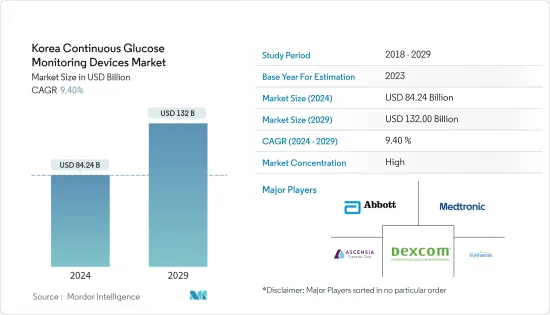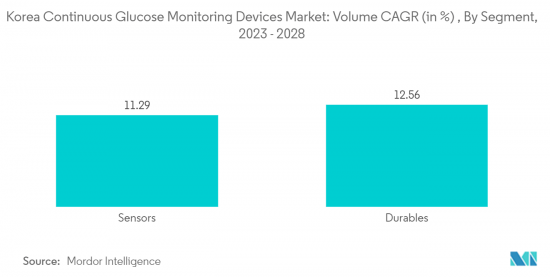PUBLISHER: Mordor Intelligence | PRODUCT CODE: 1408180

PUBLISHER: Mordor Intelligence | PRODUCT CODE: 1408180
Korea Continuous Glucose Monitoring Devices - Market Share Analysis, Industry Trends & Statistics, Growth Forecasts 2024 - 2029

The Korea Continuous Glucose Monitoring Devices Market size is estimated at USD 84.24 billion in 2024, and is expected to reach USD 132 billion by 2029, growing at a CAGR of 9.40% during the forecast period (2024-2029).
Diabetes was one of the main comorbidities closely related to the risk of mortality and severe clinical outcomes in patients with COVID-19. Numerous epidemiological findings consistently suggested that the proportion of diabetes was higher in COVID-19 patients with a severe clinical course and that people with diabetes were also more vulnerable to COVID-19 infection than those without diabetes.
During the pandemic, health providers or diabetic patients were required to minimize contact and quarantine, and telehealth provided alternative support in preventing acute complications and controlling severe hyperglycemia. People with diabetes who were not infected with the SARS-CoV-2 were also recommended to maintain optimal glycemic control as part of the primary prevention of COVID-19.
The primary use of CGMS is for patients with type 1 or severe type 2 diabetes who are on insulin therapy. If insulin-dependent diabetics are dependent on SBGM, they should prick their fingers with needles up to 10 times a day to draw blood to measure blood glucose and, depending on the situation, inject insulin to avoid hyperglycemic or hypoglycemic shock. On the other hand, CGMS users can monitor their blood glucose changes for 1-7 days without any additional blood draw with a single sensor insertion.
The key factors propelling the market studied are increasing diabetes prevalence and the support initiatives taken by the Korean government.
Korea Continuous Glucose Monitoring Devices Market Trends
The Durables Segment is Expected to Witness the Highest Growth Rate Over the Forecast Period
A sensor's transmitter is what communicates blood glucose readings to a reader, receiver, or smartphone app. Devices known as receivers are those that collect data from transmitters and present the results on various user interfaces. According to the manufacturer, various CGM device components operate differently. These gadgets may need to be applied to the skin and are sometimes visible. Both disposable and rechargeable transmitter batteries are available. The market sector is anticipated to expand as a result of rising CGM device usage among diabetics, rising underlying causes of diabetes, market product availability, benefits of these durables, and increased awareness of CGM device use among Japanese consumers.
Korean NHIS is a single, compulsory health insurance system managed by the Korean government, providing healthcare coverage to almost the entire Korean population. The Korean NHIS database includes sociodemographic information, the use of medical services, medical claims, and health examinations. Koreans must register with NHIS as Type 1 Diabetics before requesting any insurance rebates, whether for consumables or CGMS. The patient can simply confirm this a day or two later by calling the NHI call center, but the patient's doctor will be able to do that for them. In order to apply for a refund for CGM Durables, Koreans needed an NHI refund form, prescription, cash receipt, and transaction statement.
Factors such as the increasing prevalence of diabetes, coupled with the increasing initiatives by public and private organizations, are expected to increase market growth in the country over the forecast period.

Rising Prevalence of Diabetes
The Type 1 diabetes population in Korea is expected to increase at a CAGR greater than 0.35% over the forecast period.
Type 1 diabetes and Type 2 diabetes are both chronic diseases characterized by high levels of glucose (sugar) in the blood. However, they differ in their causes, symptoms, and risk factors. Type 1 diabetes, also known as insulin-dependent diabetes, is caused by an autoimmune attack on the insulin-producing cells in the pancreas, leading to a complete lack of insulin production. It typically develops in childhood or early adulthood and requires daily injections of insulin to manage. Type 2 diabetes, on the other hand, is caused by insulin resistance (when the body can't effectively use insulin) combined with a decrease in insulin production. It is usually linked to lifestyle factors such as poor diet, lack of physical activity, and obesity and is more common in adults. It can often be managed through lifestyle changes such as diet and exercise, although some people with type 2 diabetes may also need medication or insulin therapy. Both types of diabetes can lead to serious health complications if not properly managed.
In January 2022, the Ministry of Food and Drug Safety (MFDS), South Korea's medical device market regulator, planned to roll out several amendments to the country's Medical Devices Act and has also expanded its list of devices eligible for electronic indications for use. Penetration of remote patient monitoring devices in the South Korean market supports local clinical research organizations (CROs) in their clinical research trials and ensures ease of monitoring, which facilitates the discovery process.
Diabetes is one of the country's most prevalent chronic diseases. Thus, the increasing prevalence of diabetes is expected to increase the adoption of continuous glucose monitoring in the country, which is expected to increase market growth over the forecast period.
Korea Continuous Glucose Monitoring Devices Industry Overview
The Korean continuous glucose monitoring devices market is highly consolidated. Market leaders such as Dexcom, Abbott, and Medtronic are focusing on product launches and technological collaborations to increase their foothold in the market.
Additional Benefits:
- The market estimate (ME) sheet in Excel format
- 3 months of analyst support
TABLE OF CONTENTS
1 INTRODUCTION
- 1.1 Study Assumptions and Market Definition
- 1.2 Scope of the Study
2 RESEARCH METHODOLOGY
3 EXECUTIVE SUMMARY
4 MARKET DYNAMICS
- 4.1 Market Overview
- 4.2 Market Dynamics
- 4.2.1 Market Drivers
- 4.2.2 Market Restraints
- 4.3 Industry Attractiveness - Porter's Five Forces
- 4.3.1 Bargaining Power of Suppliers
- 4.3.2 Bargaining Power of Consumers
- 4.3.3 Threat of New Entrants
- 4.3.4 Threat of Substitute Products and Services
- 4.3.5 Intensity of Competitive Rivalry
5 Market Segmentation
- 5.1 By Component
- 5.1.1 Sensors
- 5.1.2 Durables (Receivers and Transmitters)
- 5.2 CGM Device Users
- 5.2.1 Seoul
- 5.2.2 Busan
- 5.2.3 Daegu Metropolitan City
- 5.2.4 Incheon Metropolitan City
- 5.2.5 Gwangju
- 5.2.6 Daejeon
- 5.2.7 Ulsan Metropolitan City
- 5.2.8 Sejong Special Self-Governing City
- 5.2.9 Gyeonggi-do
- 5.2.10 Gangwon-do
- 5.2.11 Chung-cheong bukdo
- 5.2.12 Chungcheongnam-do
- 5.2.13 Jeollabuk do
- 5.2.14 Jeollanam-do
- 5.2.15 Gyeongsangbuk-do
- 5.2.16 Gyeongsangnam-do
- 5.2.17 Special Self-governing Province
- 5.3 By Provinces
- 5.3.1 Seoul
- 5.3.2 Busan
- 5.3.3 Daegu Metropolitan City
- 5.3.4 Incheon Metropolitan City
- 5.3.5 Gwangju
- 5.3.6 Daejeon
- 5.3.7 Ulsan Metropolitan City
- 5.3.8 Sejong Special Self-Governing City
- 5.3.9 Gyeonggi-do
- 5.3.10 Gangwon-do
- 5.3.11 Chung-cheong bukdo
- 5.3.12 Chungcheongnam-do
- 5.3.13 Jeollabuk do
- 5.3.14 Jeollanam-do
- 5.3.15 Gyeongsangbuk-do
- 5.3.16 Gyeongsangnam-do
- 5.3.17 Special Self-governing Province
- 5.4 Market Share by Public and Private
- 5.5 Analysis of CGM Device Distribution Channels (Includes Percentage Share of Hospitals, Clinics, Pharmacies, and Other Modes)
- 5.6 Analysis of CGM Device Prescribers (Includes Percentage Share of Endocrinologists, Diabetologists, Other HCP Specialties, and Prescribers Knowledge of CGM Devices)
6 Market Indicators
- 6.1 Type-1 Diabetes Population
- 6.2 Type-2 Diabetes Population
7 COMPETITIVE LANDSCAPE
- 7.1 Company Profiles
- 7.1.1 Abbott Diabetes Care Inc.
- 7.1.2 Dexcom Inc.
- 7.1.3 Medtronic PLC
- 7.1.4 Eversense
- 7.1.5 Ascensia
- 7.2 Company Share Analysis
- 7.2.1 Abbott Diabetes Care Inc.
- 7.2.2 Dexcom Inc.
- 7.2.3 Medtronic PLC
- 7.2.4 Other Companies
8 MARKET OPPORTUNITIES AND FUTURE TRENDS




